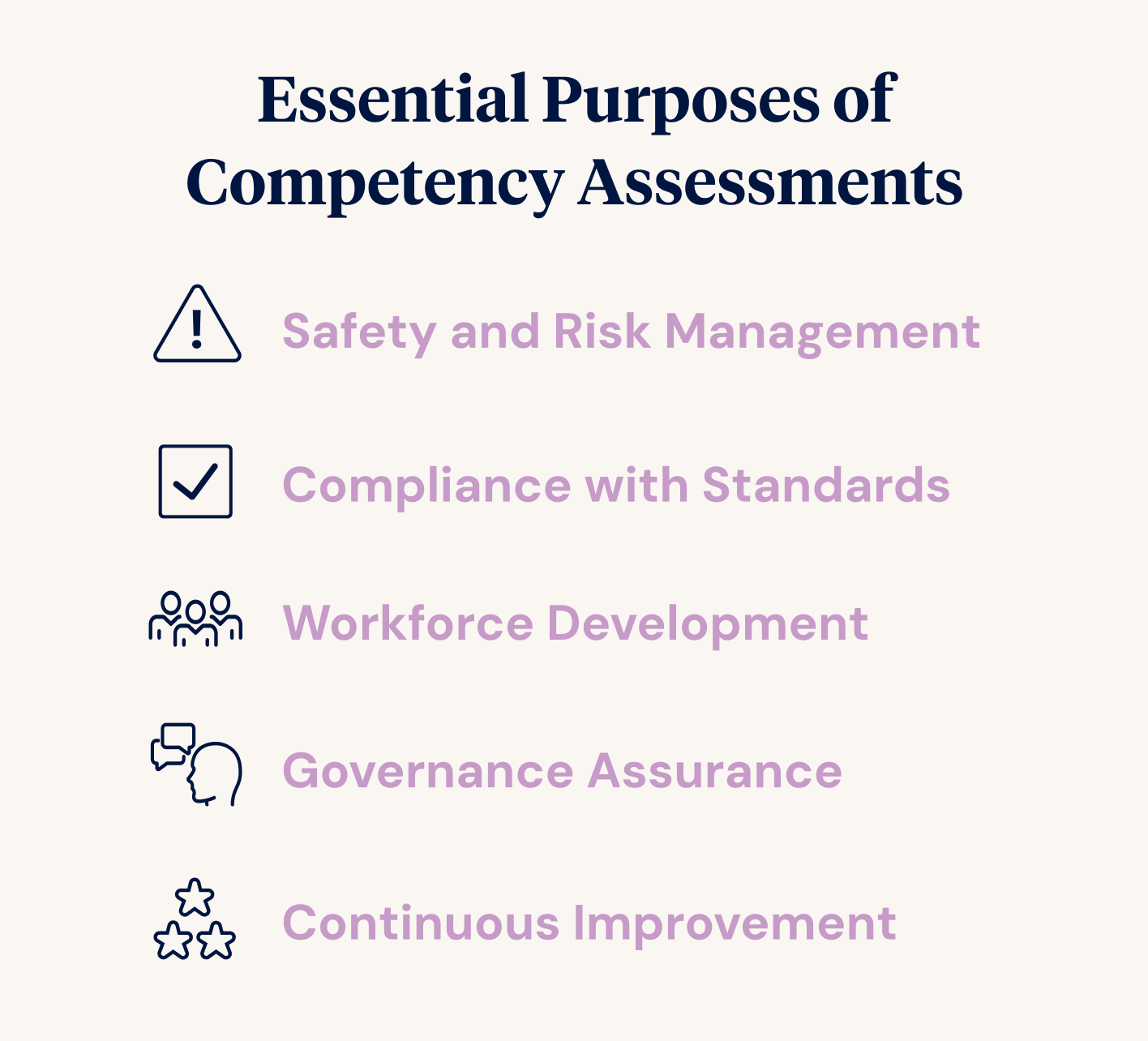Purpose of this Guide
Competency assessments aren’t just compliance tools. They are critical for ensuring healthcare staff are confident, capable, competent, safe, and consistent in meeting the demands of their roles. This guide will explore competency assessments, why they matter, and how to implement them meaningfully to improve real outcomes and reduce risk.
What Is a Competency Assessment?
Competency assessments are structured processes used to determine whether a person can demonstrate the necessary knowledge, skills, and behaviours required to perform specific tasks effectively, consistently, and safely.
Like mandatory training, competency assessments are not just a compliance tickbox. They are strategic tools for strengthening workforce capability and improving care outcomes.
Done well, competency assessments:
- Validate a person’s ability to perform a job role
- Build confidence and professional identity
- Provide evidence for leadership and regulators
- Inform training and professional development
Why Are Competency Assessments Needed?

Competency assessments serve multiple essential purposes:
- Safety and Risk Management: Ensuring that care is delivered by capable staff reduces the risk of harm to consumers and staff.
- Compliance with Standards: Action 2.9.6 of the Strengthened Aged Care Quality Standards requires all aged care workers to regularly receive competency-based training in core matters, such as:
- Person-centred, rights-based care
- Culturally safe, trauma-aware and healing-informed care
- Dementia care
- Responding to medical emergencies
- Code of Conduct
- Serious Incident Response Scheme (SIRS)
- Strengthened Quality Standards
- Workforce Development: Competency assessments guide targeted training and support mentoring conversations.
- Governance Assurance: Provides evidence that leaders can use to make decisions and report to boards, regulators, and consumers.
- Continuous Improvement: Reveals trends and gaps that inform system-wide improvements.
When embedded into a structured Competency-Based Education (CBE) system, competency assessments empower staff, reduce care risks, and contribute to high-quality care
Benefits of Competency Assessments
Rather than viewing competency assessments as a burden, think of them as enablers:
| Benefit | Description |
|---|---|
| Confidence | Verifies staff capabilities, building trust and morale. |
| Safety | Prevents assumptions and ensures staff are fit for the task. |
| Governance | Provides audit-ready evidence and clear insights for leaders. |
| Workforce Development | Informs targeted learning, supervision, and mentoring. |
| Continuous Improvement | Assessment results feed back into service planning and QI. |
Key definitions:
- Competence: Overall ability to perform a job effectively, integrating knowledge, skill, and behaviour.
- Competency: A measurable ability to apply knowledge and skills in specific situations.
- Competency Assessment: The process of measuring and documenting competency through valid, objective, and reliable methods.
- Verification: The confirmation that competency has been demonstrated to the required standard.
When Does Competency Assessment Occur?
Competency assessments can occur throughout an individual’s career, depending on workplace needs and regulatory requirements. Common situations include:
- Onboarding: New staff are assessed to ensure they meet the baseline competencies required for their roles.
- Periodic Reviews: Regular assessments validate ongoing competence and identify areas for further development.
- Post-Incident Evaluations: After incidents, assessments evaluate staff performance in high-risk tasks and guide corrective actions.
- Role Transitions: When staff take on new responsibilities, competency assessments ensure readiness for the change.
Who’s Involved?
Assessors
Assessors are responsible for evaluating performance fairly and consistently. They may include:
- Clinical supervisors or educators (e.g. RNs with expertise in the assessed skill)
- Training coordinators or managers (especially for organisational policies or mandatory training)
- Other trained assessors, such as those with assessment qualifications
Assessors must be supported with clear rubrics, guidance, and governance to ensure service standardisation.
Assessees
These are the individuals being assessed. They include:
- Registered Nurses (RNs): Assessed on advanced skills like medication administration or complex wound care
- Enrolled Nurses (ENs): Assessed on foundational clinical procedures
- Care Workers: Assessed on core care tasks like mobility support, infection control, and hygiene
- Non-Clinical Staff: E.g. cleaners, food service, admin — assessed on safety, communication, and support tasks
The person’s role, scope, and setting determine what they are assessed on.
Challenges in Current Practice
Despite their value, competency assessments are often poorly executed. Common issues include:
- Paper-based systems: Difficult to manage, prone to errors and unable to support real-time visibility or data-driven decision making.
- Inconsistent assessor practice: No standardised method = inconsistent outcomes.
- Disconnected systems: No data integration between training, incidents, and workforce plans.
- Poor role differentiation: Generic, one-size-fits-all assessments fail to reflect the unique responsibilities, risks and context of different roles.
- Equity barriers: Assessments that don’t support staff with low literacy levels or English as a second language create unnecessary disadvantage, and even disengagement.
- Missing Feedback Loops: Assessment data is rarely used to inform supervision, CPD planning or system improvement initiatives.
- Competency Currency Gaps: Without scheduled reassessment, it’s difficult to ensure staff maintain competence over time and with the most current competencies.
The result? Missed development opportunities, audit vulnerabilities, workforce disengagement, and poor visibility for leaders.
The challenge of reliably assessing skills is particularly pressing for the mobile workforce, such as home care staff or clinicians working in rural, remote, or isolated practice.
What Best Practice Looks Like
Best practice competency assessments are:
- Standardised: Aligned with verified competency framework
- Risk-informed: Tailored to job roles and organisational context
- Inclusive: Adaptable to diverse literacy and learning needs
- Integrated: Linked with digital systems and workforce data
- Verified: Uses multiple, flexible methods to confirm performance
Verification Methods
Donna Wright (Creative Healthcare Management) outlines 11 effective verification methods:
- Observation / Return demonstration
- Peer review / Feedback
- Case studies / Exemplars
- Self-assessment
- Tests / Quizzes
- Reflection discussions
- Mock events
- Presentations
- Quality monitors
- Evidence of daily work
- Survey/Customer feedback
This variety ensures assessments are relevant, inclusive, and authentic.
The Role of Verification
Verification is central to proving competency. Verification is the evidence that demonstrates competence. It ensures that assessment findings are:
- Accurate
- Objective
- Standardised
Assessors must use methods appropriate to the:
- Risk level of the competency
- Role and scope of the worker
- Setting (real-world vs simulation)
- Needs of the staff (language, experience)
Verification methods must be documented and repeatable. Assessors need clear rubrics and support to ensure fairness and consistency.
Remember:
- Assessment measures
- Verification confirms
What Is Competency-Based Education?
Competency-Based Education (CBE) is an approach that combines training and assessment, focused on the learner’s ability to apply knowledge and skills in real-world scenarios. It is:
- Proactive
- Practical
- Purposeful
CBE is aligned with outcome-based regulatory expectations, such as the strengthened Standards. It supports consistent, safe and person-centred care.
Is Competency Assessment Considered CPD?
No, not on its own.
Competency assessment is verification, not education. It confirms whether an individual has the knowledge, skills and behaviours required to meet the defined standard. While competency assessments are vital for workforce assurance, they are not counted as CPD (Continuing Professional Development) unless they involve new learning.
That said, competency assessments:
- Can highlight gaps that CPD can address
- Can validate the outcomes of completed CPD activities
- May form part of a CPD portfolio if linked to reflective learning or skill enhancement
For example, a nurse completes CPD on pain management and then undergoes a competency assessment on opioid administration. The training is CPD, and the assessment verifies applied learning.
In summary, competency assessment confirms ability, CPD builds it.
Core Matters: Compliance vs Capability
Action 2.9.6 sets a clear regulatory baseline. We must:
- Provide competency-based training on the core matters.
- Assess if individuals can demonstrate core skills.
- Show that a system exists to evaluate and track competency.
But we must not stop at compliance. Competency assessments should be tools for quality assurance, not tick-box exercises.
Ausmed’s Approach to Competency Assessments
Ausmed is reimagining competency assessments through:
- A library of customisable and editable competency assessment templates, aligned with regulatory requirements
- Role and scope-specific assessments
- Inclusive language and support tools
- Integration with learning from the Ausmed Library™
Development Process
- Topic Selection: Evidence-based, risk-informed, mapped to mandatory training
- Audience Definition: Clear delineation of job role, scope, language, and experience
- Structure Planning: Knowledge, Skills, and Attitude/Behaviour Components
- Assessment Design: Inclusive, flexible verification methods
- Academic Integrity Review: Ensuring fairness, validity and outcome alignment
- Clinical Governance Review: Risk evaluation, safety assurance, currency
- Publishing: In line with Ausmed’s internal governance procedures
What We’re Really Building
We are not building systems to pass audits. We are building systems that empower our workforce to deliver excellent care every day.
Competency assessments are not paperwork. They are proof of practice.
They show:
- That our people can do their jobs.
- That they are supported to improve.
- That care is delivered safely, consistently, and in line with what matters most.



